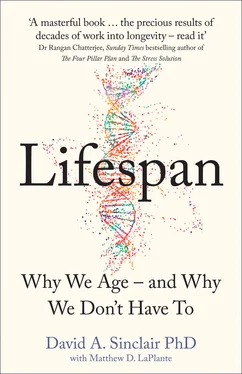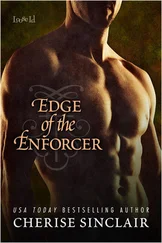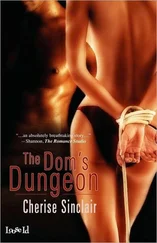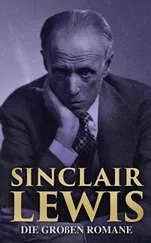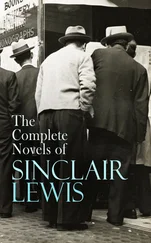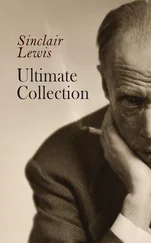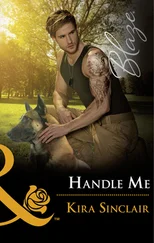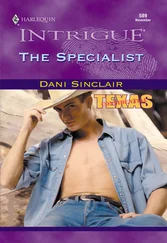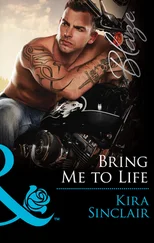But what if it didn’t have to be that way? What if we could be younger longer? Not years longer but decades longer. What if those final years didn’t look so terribly different from the years that came before them? And what if, by saving ourselves, we could also save the world?
Maybe we can never be six again—but how about twenty-six or thirty-six?
What if we could play as children do, deeper into our lives, without worrying about moving on to the things adults have to do so soon? What if all of the things we need to compress into our teenage years didn’t need to be so compressed after all? What if we weren’t so stressed in our 20s? What if we weren’t feeling middle-aged in our 30s and 40s? What if, in our 50s, we wanted to reinvent ourselves and couldn’t think of a single reason why we shouldn’t? What if, in our 60s, we weren’t fretting about leaving a legacy but beginning one?
What if we didn’t have to worry that the clock was ticking? And what if I told you that soon—very soon, in fact—we won’t?
Well, that’s what I’m telling you.
I’m fortunate that after thirty years of searching for truths about human biology, I find myself in a unique position. If you were to visit me in Boston, you’d most likely find me hanging out in my lab at Harvard Medical School, where I’m a professor in the Department of Genetics and codirector of the Paul F. Glenn Center for the Biological Mechanisms of Aging. I also run a sister lab at my alma mater, the University of New South Wales in Sydney. In my labs, teams of brilliant students and PhDs have both accelerated and reversed aging in model organisms and have been responsible for some of the most cited research in the field, published in some of the world’s top scientific journals. I am also a cofounder of a journal, Aging , that provides space to other scientists to publish their research on one of the most challenging and exciting questions of our time, and a cofounder of the Academy for Health and Lifespan Research, a group of the top twenty researchers in aging worldwide.
In trying to make practical use of my discoveries, I’ve helped start a number of biotechnology companies and sit as a chair of the scientific boards of advisers of several others. These companies work with hundreds of leading academics in scientific areas ranging from the origin of life to genomics to pharmaceuticals. 7I am, of course, aware of my own labs’ discoveries years before they are made public, but through these associations, I’m also aware of many other transformational discoveries ahead of time, sometimes a decade ahead. The coming pages will serve as your backstage pass and your front-row seat.
Having received the equivalent of a knighthood in Australia and taken on the role of an ambassador, I’ve been spending quite a bit of my time briefing political and business leaders around the world about the ways our understanding of aging is changing—and what that means for humanity going forward. 8
I’ve applied many of my scientific findings to my own life, as have many of my family members, friends, and colleagues. The results—which, it should be noted, are completely anecdotal—are encouraging. I’m now 50, and I feel like a kid. My wife and kids will tell you I act like one, too.
That includes being a stickybeak , the Australian term for someone who is overly inquisitive, perhaps derived from the currawong crows that used to punch through the foil lids of the milk bottles delivered to our homes and drink the milk out of them. My old high school friends still like to tease me about how, whenever they came over to my parents’ house, they would find me pulling something apart: a pet moth’s cocoon, a spider’s curled-up leaf shelter, an old computer, my father’s tools, a car. I became quite good at it. I just wasn’t very good at putting these things back together.
I couldn’t bear not knowing how something worked or where it came from. I still can’t—but at least now I get paid for it.
My childhood home is perched on a rocky mountainside. Below is a river that runs into Sydney Harbor. Arthur Phillip, the first governor of New South Wales, explored these valleys in April 1788, only a few months after he and his First Fleet of marines, prisoners, and their families established a colony on the shores of what he called the “finest and most extensive harbor in the universe.” The person most responsible for him being there was the botanist Sir Joseph Banks, who eighteen years earlier had sailed up the Australian coastline with Captain James Cook on his “voyage round the world.” 9
After returning to London with hundreds of plant specimens to impress his colleagues, Banks lobbied King George III to start a British penal colony on the continent, the best site for which, he argued, not coincidentally, would be a bay called “Botany” on “Cape Banks.” 10The First Fleet settlers soon discovered that Botany Bay, despite its most excellent name, had no source of water, so they sailed up to Sydney Harbor and found one of the world’s largest “rias,” a highly branched, deep waterway that formed when the Hawkesbury River system had been flooded by rising sea levels after the last ice age.
At the age of 10, I had already discovered through exploration that the river in my backyard flowed down into Middle Harbor, a branch of Sydney Harbor. But I could no longer stand not knowing where the river originated. I needed to know what the beginning of a river looked like.
I followed it upstream, left the first time it forked and right the time after that, wending into and out of several suburbs. By nightfall I was miles from home, beyond the last mountain on the horizon. I had to ask a stranger to let me call my mother to beg her to come pick me up. A few times after that I tried searching upstream, but never did get anywhere close to the fount. Like Juan Ponce de León, the Spanish explorer of Florida known for his apocryphal quest to find the Fountain of Youth, I failed. 11
Ever since I can remember, I have wanted to understand why we grow old. But finding the source of a complex biological process is like searching for the spring at the source of a river: it’s not easy.
On my quest, I’ve wound my way left and right and had days when I wanted to give up. But I’ve persevered. Along the way, I have seen a lot of tributaries, but I’ve also found what may be the spring. In the coming pages, I will present a new idea about why aging evolved and how it fits into what I call the Information Theory of Aging. I will also tell you why I have come to see aging as a disease—the most common disease—one that not only can but should be aggressively treated. That’s part I.
In part II, I will introduce you to the steps that can be taken right now—and new therapies in development—that may slow, stop, or reverse aging, bringing an end to aging as we know it.
And yes, I fully recognize the implications of the words “bringing an end to aging as we know it,” so, in part III, I will acknowledge the many possible futures these actions could create and propose a path to a future that we can look forward to, a world in which the way we can get to an increased lifespan is through an ever-rising healthspan , the portion of our lives spent without disease or disability.
There are plenty of people who will tell you that’s a fairy tale—closer to the works of H. G. Wells than those of C. R. Darwin. Some of them are very smart. A few are even people who understand human biology quite well and whom I respect.
Those people will tell you that our modern lifestyles have cursed us with shortening lifespans. They’ll say you’re unlikely to see 100 years of age and that your children aren’t likely to get to the century mark, either. They’ll say they’ve looked at the science of it all and done the projections, and it sure doesn’t seem likely that your grandchildren will get to their 100th birthdays, either. And they’ll say that if you do get to 100, you probably won’t get there healthy and you definitely won’t be there for long. And if they grant you that people will live longer, they’ll tell you that it’s the worst thing for this planet. Humans are the enemy!
Читать дальше
